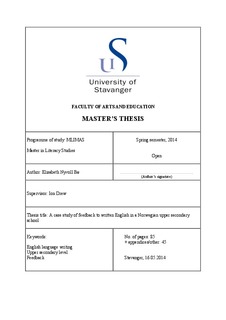| dc.description.abstract | This thesis is about a study of English writing and feedback in an upper secondary school in Norway. The ability to express oneself in writing is one of the five basic skills in the Norwegian LK06 English subject curriculum. However, some Norwegian studies (e.g. Lehmann 1999; Nygaard 2010) indicate that Norwegian students’ writing skills in English are inadequate. How teachers teach English writing is therefore important to investigate, and feedback is one important factor of teaching and developing writing.
Theory on L1 and L2 writing is presented in the study, in addition to summative and formative assessment in writing, with process writing as one form of formative assessment. Research on feedback is also thoroughly presented.
The study investigates the students’ and teachers’ experiences and attitudes to English writing and feedback in the upper secondary school. It looks into how teachers provide feedback to English writing and how students receive feedback. Both the students’ and teachers’ attitudes to English writing and feedback are investigated. In addition, the study also explores how feedback influences the development of the students’ writing by analysing some of the students’ drafts.
The study used mixed methods, both qualitative and quantitative research methods. Semi-structured interviews with three teachers were conducted, questionnaires were answered by 83 students and four student texts were analysed. The teacher interviews showed that the teachers provided feedback in a rather similar way, namely that they gave mostly post-product feedback. However, one of the teachers asked the students to revise their texts after they had received feedback and their grades, while the other two required no revisions at all. Process writing, multiple drafts or peer feedback were not common in the teaching of English writing, even though the teachers said there were benefits with, for example, process writing. The teachers gave both written and oral feedback, with an emphasis on written feedback. However, they wished they could give more oral feedback. Thus, the teachers did not always practise what they thought was most beneficial for their students because they felt they did not have enough time.
The questionnaires showed that the majority of the students produced texts in a similar way, namely they wrote one text without drafts and feedback. They claimed to receive mostly written feedback, and the feedback was mostly given at the same time as the grade, in other words it was post-product feedback.
The analysis of student texts showed that the students who were required to revise their texts, improved them as a result of the feedback. However, most of the revisions were done in terms of language, and the teacher’s comments on content were not responded to by these students.
This thesis has made a contribution to the research on English writing and feedback in upper secondary education in Norway by focusing on writing and feedback in one upper secondary school and using a mixed methods approach. It has provided insight into the experiences and attitudes to written feedback, both from the students’ and teachers’ perspectives, as well as including a study of some texts. The study confirms other research in this field (i.e. Vik 2013), namely that written feedback at the upper secondary schools that have been studied is primarily post-product feedback, because the teachers do not seem to have time to practise pre-product feedback. | nb_NO |
